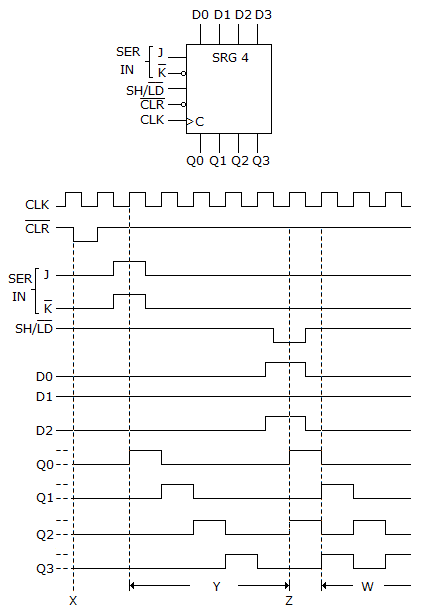Discussion
Home ‣ Digital Electronics ‣ Counters Comments
- Question
The circuit given below fails to produce data output. The individual flip-flops are checked with a logic probe and pulser, and each checks OK. What could be causing the problem?

Options- A. The data output line may be grounded.
- B. One of the clock input lines may be open.
- C. One of the interconnect lines between two stages may have a solder bridge to ground.
- D. One of the flip-flops may have a solder bridge between its input and Vcc.
- Correct Answer
- One of the clock input lines may be open.
- 1. How many flip-flops are required to construct a decade counter?
Options- A. 10
- B. 8
- C. 5
- D. 4 Discuss
- 2. List which pins need to be connected together on a 7492 to make a MOD-12 counter.
Options- A. 1 to 12, 11 to 6, 9 to 7
- B. 1 to 12, 12 to 6, 11 to 7
- C. 1 to 12, 9 to 6, 8 to 7
- D. 1 to 12 Discuss
- 3. A 4-bit ripple counter consists of flip-flops, which each have a propagation delay from clock to Q output of 15 ns. For the counter to recycle from 1111 to 0000, it takes a total of ________.
Options- A. 15 ns
- B. 30 ns
- C. 45 ns
- D. 60 ns Discuss
- 4. When two counters are cascaded, the overall MOD number is equal to the ________ of their individual MOD numbers.
Options- A. product
- B. sum
- C. log
- D. reciprocal Discuss
- 5. One of the major drawbacks to the use of asynchronous counters is:
Options- A. low-frequency applications are limited because of internal propagation delays
- B. high-frequency applications are limited because of internal propagation delays
- C. asynchronous counters do not have major drawbacks and are suitable for use in high- and low-frequency counting applications
- D. asynchronous counters do not have propagation delays and this limits their use in high-frequency applications Discuss
- 6. The process of designing a synchronous counter that will count in a nonbinary manner is primarily based on:
Options- A. external logic circuits that decode the various states of the counter to apply the correct logic levels to the J-K inputs
- B. modifying BCD counters to change states on every second input clock pulse
- C. modifying asynchronous counters to change states on every second input clock pulse
- D. elimination of the counter stages and the addition of combinational logic circuits to produce the desired counts Discuss
- 7. In a VHDL retriggerable edge-triggered one-shot, which condition will not exist when a clock edge occurs?
Options- A. A trigger edge has occurred and we must load the counter.
- B. The counter is zero and we need to keep it at zero.
- C. The shift register is reset.
- D. The counter is not zero and we need to count down by one. Discuss
- 8. To operate correctly, starting a ring counter requires:
Options- A. clearing one flip-flop and presetting all the others.
- B. clearing all the flip-flops.
- C. presetting one flip-flop and clearing all the others.
- D. presetting all the flip-flops. Discuss
- 9. What type of register is shown below?

Options- A. Parallel in/parallel out register
- B. Serial in/parallel out register
- C. Serial/parallel-in parallel-out register
- D. Parallel-access shift register Discuss
- 10. Which of the following is a type of shift register counter?
Options- A. Decade
- B. Binary
- C. Ring
- D. BCD Discuss
Counters problems
Search Results
Correct Answer: 4
Correct Answer: 1 to 12
Correct Answer: 60 ns
Correct Answer: product
Correct Answer: high-frequency applications are limited because of internal propagation delays
Correct Answer: external logic circuits that decode the various states of the counter to apply the correct logic levels to the J-K inputs
Correct Answer: The shift register is reset.
Correct Answer: presetting one flip-flop and clearing all the others.
Correct Answer: Parallel-access shift register
Correct Answer: Ring
Comments
There are no comments.More in Digital Electronics:
Programming
Copyright ©CuriousTab. All rights reserved.
